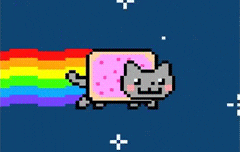Every few years, a new image format shows up promising to “replace” everything that came before.
Right now, that format is WebP – smaller files, better compression, transparency, animation support, and all the usual tech buzzwords.
But here’s the thing: none of that matters if people don’t actually use or search for it.
And outside of developer circles, almost nobody does.

1. People Search for GIFs – Not WebPs
This one is a no brainer. Online behaviour drives traffic, not file size.
People literally type:
“funny cat gif”
“reaction gif”
“sad anime gif”
They don’t type “funny cat webp.” They don’t save them. They don’t share them.
In fact, when people search for “webp,” it’s usually in frustration – “how to convert webp”, “why is everything webp”, “disable webp in browser.” There are literal browser extensions built just to stop images saving as webp.

The above tells you everything you need to know about public sentiment.
So if your content relies on discoverability or social sharing, GIF wins by language alone.
2. GIFs Are a Cultural Format
GIFs aren’t just a file type – they’re part of internet culture.
They’re shorthand for emotion, humor, and shared reaction.
When someone says “send me a GIF,” you already know what they mean – it’s a universal visual language.
WebP, on the other hand, has no cultural identity.
It’s a technical format, not a medium of expression.
No one says “send me a WebP.”
And when something becomes a meme, it’s born as a GIF, not as a WebP.
That cultural inertia keeps GIFs alive – and more visible – across social platforms, chat apps, and search engines alike.
3. Platform and Social Compatibility
Every social app, chat platform, and CMS natively supports GIFs.
They embed instantly, auto-play, and display previews perfectly.
WebP?
Half the time, it doesn’t preview, doesn’t animate, or gets converted back to another format behind the scenes.
Even where it is supported, many platforms still re-encode WebPs into JPEGs or MP4s for reliability.
In other words, WebP’s “superior efficiency” doesn’t matter if the platform just changes it anyway.
4. Technical Superiority ≠ Real-World Adoption
Developers love efficiency metrics – smaller files, fewer bytes, better compression ratios.
But end users don’t care about formats. They care about accessibility and shareability.
And what if it’s loading too long? Perhaps you should get a faster internet. Nothing should load slow in 2025.
And right now, GIF is still the only image format that guarantees universal visibility, animation, and familiarity.
If you publish in WebP only, you’re depending on a format that’s invisible to a huge chunk of human behavior – and that’s bad for exposure, no matter how efficient it is.
So what’s our take as a pro SEO agency ? We really dislike webp and whenever possible we use gif format unless the size would be absolutely insane.
| Metric | GIF | WebP |
|---|---|---|
| Human search interest | 🔥 High | 🧊 Near zero |
| Cultural relevance | ✅ Universal | ❌ None |
| Platform compatibility | ✅ Everywhere | ⚠️ Patchy |
| Tech efficiency | ❌ Larger | ✅ Smaller |
| Shareability & discoverability | ✅ Huge | ⚠️ Limited |
5. Useful Resources
Need high-quality GIFs?
GIPHY https://giphy.com
Tenor https://tenor.com/en-GB/
Want to convert or optimise GIFs? – https://ezgif.com/
Had enough of WebP files? https://support.mozilla.org/en-US/questions/1329624

